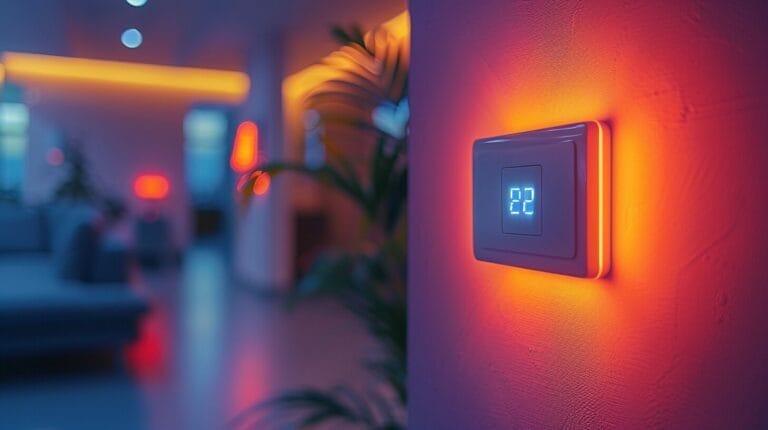How to Make DIY Colors on LED Lights: Unleash Creativity
Creating DIY colors on LED lights is akin to mixing a palette of paints on a canvas – the possibilities are endless, from a solid one color to a dynamic change colors scene.
In our How to Make DIY Colors on LED Lights guide you will understand the basics of LED lights and learn how to manipulate them. You can unleash a vibrant spectrum of colors that will not only illuminate your space but also ignite your imagination.
Key Takeaways
- RGB strips allow users to experiment with different color combinations and brightness levels, including the change colors feature with just a press of a button.
- Essential tools like DIY buttons and a remote control enable precise color adjustments.
- Mastering base colors and brightness control is crucial for creating vibrant DIY LED colors, with a simple second action to power source connect or disconnect.
- Users can easily customize colors, set ambiance, and create multi-color effects with DIY LED lights.
Understanding the Basics of LED Lights and DIY Colors

To create customized lighting effects, you must first understand the fundamentals of LED lights and DIY colors. RGB strips, consisting of red, green, and blue LEDs, can be combined to produce a myriad of colors. In DIY mode, you can adjust the brightness and mix these base colors to achieve the desired hue using a controller, often needing just a click or press of a button.
This hands-on approach allows for endless possibilities in customizing the lighting to suit specific preferences. Brightness plays a crucial role in the final outcome of DIY colors on LED lights. By adjusting the brightness levels of red, green, and blue LEDs, one can control the saturation and vividness of the colors produced.
This dynamic control over brightness allows for the creation of subtle pastel tones or vibrant, eye-catching hues. Mastering the manipulation of base colors and brightness is key to unlocking the full potential of DIY colors on LED lights.
Essential Tools and Materials for Creating DIY Colors on LED Lights

To create DIY colors on LED lights, you must first ensure you have the essential tools and materials at hand:
- Tools: DIY Buttons, Remote Control
- Materials: LED Strip Lights, RGB LED Strip Lights
DIY buttons allow you to manually adjust the colors on your LED lights with precision. A remote control further enhances the user experience by enabling convenient color changes from a distance, including the transition to a soothing white light or a bold one color display. When selecting LED strip lights, opt for RGB LED strip lights for vibrant and customizable color options.
Step-By-Step Guide to Making DIY Colors on LED Lights

Starting with a properly set up LED light strip and a ready controller, you can begin customizing your colors by selecting from a wide range of options available on your remote control. For more advanced color customization, consider utilizing Wi-Fi and App control.
Connect your LED lights to a Wi-Fi network and download the corresponding app on your smartphone. Through the app, you can access a plethora of color options and even create your own unique color combinations, or simply press for pre-designed solutions.
Creating Multi-Color Effects with Your DIY LED Lights

We can enhance the ambiance of our space by creating captivating multi-color effects using our DIY LED lights. When it comes to creating mesmerizing color change effects with our LEDs, the possibilities are endless, from cycling through a rainbow of change colors to maintaining a stable white light ambiance. Here are some innovative ways to achieve stunning multi-color effects:
- Utilize Light Strips: Experiment with different lengths and placements of light strips to create dynamic color patterns that flow seamlessly across your space.
- Explore App Control: Take advantage of app-controlled LED lights to customize color combinations, transitions, and brightness levels with just a few taps on your smartphone.
- Mix Colors with a Button: Many DIY LED light setups come with a remote control or a button that allows you to easily switch between preset color schemes or manually blend colors to suit your mood.
- Sync Lighting Effects: For a truly immersive experience, sync your LED lights with music or movies using app control features that match the lighting effects to the audio or video playing in your space.
Can Making DIY Colors on LED Lights Help Improve Night Vision for People with Astigmatism?
Making DIY colors on LED lights can potentially enhance night vision for individuals with astigmatism. By adjusting the color and brightness of LED lights, people with astigmatism can minimize glare and improve their ability to see in low light environments. These astigmatism and LED lights insights could significantly benefit those with visual impairments.
Troubleshooting Common Issues with DIY LED Light Colors

Common issues with DIY LED light colors include unresponsive remote controls and Wi-Fi/App connectivity problems. When troubleshooting these issues, start by checking the connections and batteries, looking for physical obstructions, and checking the stability of your Wi-Fi network.
If necessary, restart your router and reconfigure the app settings to establish a reliable connection for seamless color changes.
Conclusion
We hope this article has inspired you to unleash your creativity and experiment with making DIY colors on your LED lights, possibly even achieving the perfect white light for your space.
By understanding the basics of LED lights and following our step-by-step guide, you can create stunning multi-color effects to enhance any space.
Remember to troubleshoot any issues that may arise to ensure your DIY LED light colors shine bright.
Have fun and let your imagination run wild with your custom color creations!
Frequently Asked Questions
What are LED strip lights?
LED strip lights, also known as LED tape or LED ribbon lights, are flexible circuits embedded with surface-mounted light-emitting diodes (LEDs) that emit various colors of light. They are popular for ambient lighting and can be easily installed in a variety of settings.
How do RGB LED strip lights work?
RGB LED strip lights work by combining red, green, and blue LEDs on a single strip, which can be altered to emit a solid white light or vibrant change colors effects with a press. By adjusting the intensity of each color, the strip can produce a wide range of colors, allowing users to customize the lighting to suit their preferences.
What is a remote control for LED strip lights?
A remote control for LED strip lights is a device that allows users to change the colors, brightness, and effects of the LED lights without having to physically touch the strip. It provides convenience and ease of use for adjusting the lighting settings.
How can I customize the colors on LED strip lights?
To customize the colors on LED strip lights, you can use a remote control or a dedicated app to select the desired color you want. Some LED strip lights also offer pre-set color options and various effects to enhance the ambiance of your space.
What is a 5050 LED strip?
A 5050 LED strip refers to the type of LED chip used in the strip, with dimensions of 5.0mm x 5.0mm, often favored for its capability to emit bright white light. These chips are larger and brighter compared to other types, making 5050 LED strips ideal for applications where higher light output is desired.







